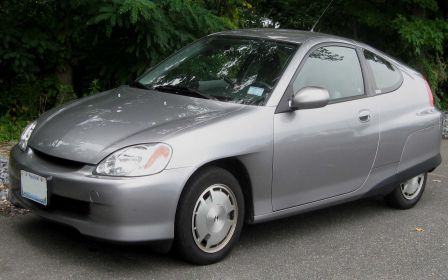Joaquin Kurz was an undergraduate student at the University of Southern California in 2000.
The release of the first hybrid electric vehicles in the United States marks the start of a revolution. Hybrid vehicles are electric cars that utilize small internal-combustion engines and an electric generator. The advantages of this concept are clear: increased fuel efficiency and reduced levels of pollution without the complications and maintenance requirements of a purely electrical-powered vehicle. This article provides some history on the hybrid concept as well as a survey of the innovative systems that have been developed in hybrid science. Current releases by Honda and Toyota are briefly examined.
Introduction
Recently there has been much excitement regarding the release of the first hybrid electric vehicles into the American consumer market. It may seem as though the hybrid concept is relatively new to the automobile industry, but this is untrue. Almost a century ago, in 1904, the concept was conceived by American engineer H. Piper [1].
For many years, the concept was widely ignored, primarily because of the high development costs and the uncertainty regarding the widespread acceptance of electric automobiles. Although Piper’s initial concept was unsuccessful, his idea would later spark the beginning of a revolution.
Hybrid Electric Vehicles: A History of Technological Innovation
The real surge in development occurred in 1993, when the Clinton administration announced the formation of the Partnership for a New Generation of Vehicles (PNGV) consortium, consisting of the “Big Three” automobile manufacturers (General Motors, Ford, and Chrysler) and about 350 smaller technical firms [1].
The federation is spending about $500 million a year (about half from federal funds) to develop a car that can travel eighty miles on a gallon of gasoline. Such a vehicle would be about three times as fuel efficient as a current, comparable, gas-fueled automobile. Furthermore, the increase in efficiency is to be achieved without reduction in performance, safety, or comfort in a vehicle that does not cost more and emits one-eighth of the pollutants. This leaves a substantial amount of work to be accomplished by 2004, when the first production-ready prototypes are to be released [2].
Despite the hurdles that still must be overcome, all major automobile manufacturers are involved in hybrid research and development. “The risk of falling behind could be fatal [to a company],” says Dr. Marc Ross, a University of Michigan physicist who conducts research on energy efficiency in automobiles [3]. Clearly, many involved in the industry see hybrid technology as an essential component of future vehicles. Today, more than twenty-five years and more than $1 billion has been spent worldwide on development of the concept. The US Department of Energy’s Hybrid Propulsion Program began in 1993 to accelerate the technological development of hybrid vehicles. The program has played a critical role in advancing the President’s PNGV initiative. Thus far, a major success of the PNGV has been the application of nickel-metal-hydride batteries, which enable twice the range of a comparable hybrid vehicle running on traditional lead-acid batteries. This is but one of the innovations that are leading the way toward the modern supercar. ”We are really converging on the 80-mpg car,” said Paul Wood, spokesman for the PNGV [4].
Now, seven years after the conception of the PNGV, additional forces have aided in speeding the development of “supercar” technology. Tough federal environmental regulations are requiring motor vehicles to further reduce emissions and improve fuel efficiency. For example, regulations of the California Air Resources Board require large-volume auto manufacturers to produce 10% of their California light-duty vehicles as zero-emissions vehicles beginning in the model year 2003 [2]. Major improvements in a host of enabling technologies have also brought the goal of the PNGV closer to reality. These developments include lighter-weight body structures, more efficient engines, better batteries, and more efficient electric motors and generators. A major catalyst in the development of the technology that is often underestimated is the declining availability and rising price of gasoline. This factor mostly affects US demand and advancement, as drivers in Europe and Japan already pay about three times as much for gasoline as do motorists in America.
The Advantages of Hybrid EV’s: Cheaper, Faster, Longer
The current push toward hybrid technology seems like a natural progression when one examines the numerous advantages that it exhibits over traditional automobiles. Many regard the vehicles as a compromise between dedicated electric vehicles and conventional internal combustion vehicles, and thus presume a 50% emission reduction over traditional automobiles. In fact, when measured on a full-fuel-cycle basis, hybrids provide almost identical emissions benefits as electric vehicles compared to today’s automobiles [5]. When pollution from the generating source that charges its batteries is taken into account, an electric vehicle is about one-tenth as polluting as a conventional internal combustion vehicle that is well-tuned. A hybrid can be about one-eighth as polluting. Moreover, with intelligent design, a hybrid can achieve several times the fuel efficiency of a gasoline-powered vehicle [5].
Hybrid technology avoids the main drawback associated with electric vehicles – a limited driving range between chargings. The few thousand electric vehicles on the road today can travel only about one hundred miles before their batteries need to be recharged. This charging process can take anywhere from two to eight hours and requires exotic equipment that is not widely available (except in some areas of California). Hybrid drivers do not have to deal with time-consuming charges or a limited range. The vehicles refuel at regular gas stations, thousands of which already exist around the country. The range-extending technology of the vehicle works without the driver ever being aware of the changes that are continuously occurring. This invisible operation, paired with expected automobile performance, is speeding the acceptance of hybrid vehicles in the consumer marketplace [5].
Efficiency
The ability of hybrid technology to extend the range of a traditional automobile is largely a function of its ability to optimize the efficiency of the power plant. Most vehicles require their full wheel power for only very short bursts. While the maximum power for most new cars sold in the US today is more than one hundred kilowatts, the average power actually used during city and highway driving is only about 7.5 kilowatts. At this typically light load, engine efficiency is very poor – usually not better than 20% [5]. In a hybrid concept, a very small primary engine operating at near maximum efficiency generates this small power level. The power of a hybrid’s internal combustion engine generally ranges from one tenth to one quarter that of a comparable automobile. An additional drivetrain, usually an electric system, is then used to supplement this configuration under varying road load requirements.
Although the typical configuration consists of a hybrid gasoline and electric drivetrain, the PNGV never specified the technology to be used in achieving its “supercar” goal. This granted automobile manufacturers flexibility in developing the most affordable solutions and provided market opportunities for unforeseen technological innovations. Numerous primary power systems have been developed and evaluated. Fuel cells that use hydrogen instead of gasoline are being developed by most major automobile manufacturers but are not expected to be suitable for another ten or twenty years. Gas turbine and compression-ignition (diesel) engines have also been tested, but suffer from low basic efficiencies, especially when scaled down to the required size. At the 1996 International Seminar on the Application of Powertrain and Fuel Technologies to Meet Emission Standards, it was concluded that only spark-ignition (gasoline) engines will easily meet future emissions requirements [6]. Practically speaking, this means that only the internal-combustion engine and battery combination has any chance of meeting the stringent requirements of the PNGV in the near future.
Possibilities, Possibilities: Serial and Parallel Hybrids
Settling on the type of powerplant in emerging hybrid electric vehicles does not nearly end the drivetrain possibilities. The various engine-battery configurations fall into two basic categories- series and parallel. In a series hybrid configuration, the internal-combustion engine drives a generator. This generator charges the vehicles batteries, which in turn drives the electric motor. Only the electric motor can power the driveshaft and the wheels. In a parallel configuration, both the electric motor and the internal-combustion engine are directly connected to the driveshaft. A parallel hybrid does not require a generator. As the engine spins the driveshaft, it simultaneously spins the rotor of the electric motor, thus creating a generator to charge the batteries. Both the parallel and the series configurations can be operated with propulsion power coming only from either the battery or the engine. In a series hybrid, the engine power must still be applied through the generator and the electric motor. In both systems, power may also be supplied by a combination of the two energy sources [5].
Furthermore, both systems can also make use of “regenerative braking” technology. This product of the electric drivetrain enables the vehicle to retain energy lost during braking and downhill coasts by harnessing the resistive force and using it to partially recharge its batteries. According to Honda press releases, “energy from forward momentum is captured during braking.” Essentially, when one reverses the flow in an electric motor and battery configuration, the motor acts as a generator. An advantage of the parallel system is that a smaller engine and motor can be used, since the two components work together. The fact that the internal combustion engine must be connected to the drivetrain limits the placement of the engine, as opposed to the freedom of location present in the series design.
Additionally, if a parallel hybrid is running solely on electric power, the batteries cannot be charged simultaneously as there is no distinct generator. The features of each configuration suit them to different driving needs. A series hybrid is generally more efficient but less powerful than a comparable parallel hybrid. This configuration is more suited to short commutes. If the vehicle is to perform and function like a traditional automobile, a parallel hybrid system may be necessary. A parallel configuration would be preferable for highway use, where bursts of speed are needed for passing. A parallel hybrid can also usually muster more speed on hills than a series hybrid, due to its power advantage.
In 1998, a joint venture of four German firms was initiated to further develop and investigate design alternatives like the series or parallel decision [4]. To determine their recommendation for a proper drive system, a comparison of eighteen alternative configurations was conducted. Ranking was based on a series of weighted factors including comfort, feasibility, efficiency, cost, and mass. The results of the comparison show a clear advantage for a single-shaft parallel hybrid system with an automated shift gearbox. The second alternative selected was a similar system with a manual gearbox. The automated system was then chosen for further development. The system was not fully worked out due to the substantial development effort required to build a compact electric motor, a hydraulic actuation system, and a complex control system run by micro-controllers , but the study still resulted in some important conclusions.
A Ham in Every Oven and a Hybrid in Every Garage
Despite some of the attractive features of a series design, most indications (including the German study) are that the PNGV and other major manufacturers will choose to focus their resources on developing parallel hybrid electric vehicles as their first prototypes. In fact, Toyota and Honda have already released models based on parallel configurations in the US this year [1]
The Honda Insight (Fig. 1) is the first automobile sold in the US that is powered by both electric and gasoline power [7]. The sleek two-seater is being released just as gasoline prices in the US reach uncomfortable levels. Primary power comes from a super-efficient three-cylinder one-liter engine. When the car’s manual transmission is in neutral, the combustion engine turns off to eliminate unnecessary pollution. The parallel configuration features an ultra-thin permanent magnet electric motor that boasts a maximum power of ten kilowatts at 3000 rpm’s. The motor boosts the vehicle’s power during acceleration and heavy loading. Battery storage consists of 120 D-cell-sized nickel-metal-hydride (Ni-MH) modules. The batteries are charged by a regenerative braking configuration [7].
Besides developments in electric motor technology, the release of the model relied heavily on several other innovations. The design boasts one of the lowest aerodynamic drag coefficients of any mass-produced vehicle, which allows the vehicle to coast longer distances when not under power. A unique aluminum ultra-light space frame is only 53% of the weight of a comparable steel structure. In fact, the entire automobile only weighs 1880 pounds, which represents a significant weight reduction from a traditional automobile. Specially-engineered tires reduce rolling friction by over 40%, while maintaining standards in terms of braking, stability, and comfort [7].
These innovations allow an impressive mileage of seventy miles per gallon of gasoline. Surprisingly, the integration of a hybrid drivetrain did not eliminate such energy-draining amenities as air conditioning and a stereo system. One tank of gas can last over one thousand miles. Honda expects to release about 4500 models to the US this year at a unit price of $21,000 [7].
Although Honda was the first corporation to release a hybrid in the U.S., Toyota has already sold over 30,000 units in Japan, where its vehicle has been on sale since 1997 [3]. The Toyota Corporation’s entry into the hybrid electric market, called the Prius (Fig. 2), differs from the Honda design in several key areas, including size and drivetrain. The vehicle is larger than the Insight and is able to seat five. Many technologies incorporated in Honda’s design are equally evident in the Toyota product, and like the Honda, regular amenities are also included on the Prius.
The primary powerplant in the Toyota is about 50% larger than the one in the Honda and features a 1.5-liter four-cylinder engine [3]. A powerful electric motor can deliver up to forty horsepower when necessary. Energy is stored in an array of forty sealed Ni-MH modules. Using an innovative “power split device,” Toyota has been able to manage the small engine so that necessary power is directed toward the drivetrain as the balance is directed toward the generator. This system is a sort of hybrid of the series and the parallel configurations. A complex computer and various, newly-developed chips and sensors allow the system to continuously vary the combination of gasoline and electric power to maximize efficiency while minimizing emissions. Together the system can deliver up to an impressive 101 horsepower to the driveshaft, while operating 86% cleaner than the federally required fleet average.
Unlike the Honda design, the Prius often runs on electricity alone during light load situations. At about fifteen miles per hour, the electric system yields to the internal-combustion engine. As featured on the Insight, the Prius engine turns off when idling and features specially engineered tires and a regenerative braking system. The vehicle achieves an estimated sixty-six miles per gallon and boasts a top speed of 100 mph [2].
The Hybrids of the Future
Honda and Toyota are hardly leading the pack. Both the Mitsubishi and the Nissan Corporation plan releases of their hybrid electric vehicles in Japan later this year. Although the “Big Three” American manufacturers have yet to release their initial designs, Daimler-Chrysler may release a Dodge Durango hybrid soon. Initial testing proves that even a V6 engine modified with a hybrid electric motor is more powerful than the current standard 5.9 liter V8 engine, while providing additional fuel-efficiency advantages [3].
The release of the first hybrid electric vehicles in the US marks the start of a revolution. The hybrid electric concept is characterized by numerous advantages over traditional internal-combustion powered vehicles. Reduced levels of pollutants, greater fuel-efficiency, comfort, and convenience are all possible with a quality hybrid design. Cost and still-developing technology are the remaining obstacles in a fast-moving race toward the modern-day “supercar”. Although current releases are impressive in terms of quality, efficiency, and design, the future is sure to bring ever more incredible developments in hybrid science.
References
-
- [1] V. Wouk. “Hybrid Electric Vehicles”. Scientific American, pp. 70-74, Oct. 1997.
- [2]R. Ford. “Auto makers unveil high-mileage hybrids.” The Boston Globe, Dec. 6, 1999.
- [3] J. Bruggers. “Electric hybrids jolt auto industry, but models are tough to find in”. The Courier-Journal, Mar. 6, 2000.
- [4] J. Yamaguchi. “Tech Briefs.” Automotive Engineering, pp. 55-58, Jul. 1997.
- [5] C. Mendler. “Taking a new look at hybrid electric vehicle efficiency.” Automotive Engineering, pp. 67-70, Feb. 1997.
- [6] W. Moeller and S. Ochs. “Electric vehicle drive systems.” Automotive Engineering, pp. 259-265, Feb. 1998.
- [7] D. Chao. “Insight hybrid gets eco-friendly.” The Toronto Sun, Feb. 17, 2000.





